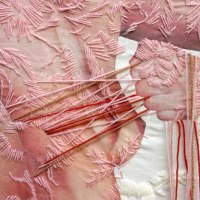 all images © Tracy Matlock
all images © Tracy Matlock
“[…] there are a few bloggers whom I know only from their blogs. These are blogs I follow because I stumbled onto them, usually by clicking on a link in someone else’s blog. What keeps me coming back is the sheer quality of their online work, and whatever feeling I begin to develop for the personality behind the work. Like a teenage girl following the latest antics of Justin Bieber or Lindsay Lohan, I have devoted a small but significant amount of brain space to these strangers, on a daily or at least weekly basis. And just as that teenage girl thinks of Justin Bieber or Lindsay Lohan as someone she knows on some strange level, these bloggers don’t feel like strangers to me either. Actually, they feel like celebrities—because, as with performers and politicians and athletes, all I know about them are their public faces, the faces they present through their blogs.
So meet my personal Internet celebrity.[Traci Matlock]”
 all images © Tracy Matlock
all images © Tracy Matlock
“[…]
JL: Something that fascinates me is the difference between a photo-blog, or at least a good photo-blog, and a photo album on Facebook.
Tracy Matlock: Right. [Laughs]
JL: That you’re constructing, and you’re curating, and what you don’t show is as important as what you do show.
TM: Oh, yes, I definitely agree with that. Not just for me, but I feel that all the time when I look at other people’s work online—especially with photographs, because we see them so often. Now with social networking, we’re inundated by photographs people think are good photographs or attractive photographs or interesting photographs in subject matter. However …
JL: Do you get judgmental about other people’s photos?
TM: Oh, yeah, probably, but in the opposite way that you perhaps are asking. I love other people’s photographs. I’m a sucker. I could stare at other people’s snapshots, and just Facebook photos, for hours. I think that they’re—they’re magic. I mean, I wish that I could make just half of what these random people online accidentally make.

 all images © Tracy Matlock
all images © Tracy Matlock
[…]
JL: There are a couple of themes that you return to again and again. Can I tick them off, and you can tell me what draws you to them? I notice you’ve been taking more photos, or publishing more photos, of strangers, especially from the back.
TM: Yeah, I’m fascinated by it. I absolutely believe it stems from asking people to show themselves to me from the front—that now, I’m really curious as to how they show themselves to me from the back, whether they know it or not.
JL: [How about] shots from the front seat of a car? Is that just because you live in Houston?
TM: I’m utter freedom in a car. It’s so chaotic. I just feel like I exist in a higher plane when I’m in a car, whether I’m driving or not. It’s so fast, and you have absolutely no idea when someone is going to change lanes, or step on the brakes, or … I think it’s extremely beautiful. And I live in a city that allows you to have your windows rolled down all the time. It’s all of that combined. And it’s window light. You’re in this space that is literally surrounded by window light, which is the most beautiful light in existence.
JL: And frames.
TM: Yes! All the time! Your back window, your windshield, your mirror—you have three mirrors in a car; it’s the
very least that you can see at all times.
JL: And, of course, mirrors are also something that come up again and again in your work. Especially yourself in the mirror—but not always yourself.
TM: That’s true, and I think mostly that’s because I really do miss photographing other people. [Laughs] … It’s not the only reason, obviously, but it is something I think about almost every time.

 all images © Tracy Matlock
all images © Tracy Matlock
[…]
JL: Another one that’s come up again and again is people viewed through water, people in water. What does water mean to you? That’s like the stupidest question in the world, but it clearly does mean something.
TM: Oh, no, no! I mean, I do think about symbolically what it means, in a lot of ways, but mostly I love the refractions of it. I just love the distortion of the body in any way … I think it’s exquisite. I mean, their figure changes, and morphs into this totally unrecognizable part of themselves, which is more themselves. The refractions of water are tantalizing.
JL: When you say the distortion of the body, that’s something else that comes up. Scars, bruises, striations, often on your own extremities… I feel I owe you a debt of thanks, because you’ve helped me to see as beautiful something that I did not always see as beautiful.
 all images © Tracy Matlock
all images © Tracy Matlock
[…]
JL: Do you ever look at a photo, even a self-portrait, and think of yourself as an object?
TM: I try to! I think that’s a really interesting way to think about it, and I try to think about the photos from both angles. I mean, on the same note, I also try to think of photos of other people as the subject, and me as the object, but as the creator, the purveyor of sorts. I do see sometimes the photos that I share of me, and I do see me in them sometimes as the object. I mean, I think it’s necessary sometimes to share work in that way. And it’s fun! I don’t think there’s absolutely anything that I shouldn’t be able to do.
JL: You don’t seem to have a lot of vanity in the way you portray yourself. You’ll show yourself looking puffy, which even famous photographers who are famous for their self-portraits don’t often do.
TM: The photos of me that I share where I’m not … the typical idea of attractive, or held together, or showing myself in a good light—those to me are the most beautiful. The photos of me crying, when my face is swollen, are the photos of me that look the most like me, to me. And I glorify those, not just to glorify my appreciation of those mental states, but also because I think that in those times in which we are kind of ugly, quote-unquote physically ugly, those are the times in which our faces take on this really extraordinary and new dimension. We see ourselves in this way that we don’t get to see people all the time. It’s so intimate, and vulgar-seeming, that it’s really beautiful. My favorite time to see my face is right when I get up in the morning, when my eyes are almost swollen shut, and my nose is all swollen, and my skin color is kind of off … I mean, I swear, when I get up in the morning, and I see my face all swollen, I wish that I could see myself like that for the rest of the day. And I know that it’s because I don’t get to see myself like that very often that that’s my favorite. I’m not used to that gaze, and therefore it’s constantly surprising me, and constantly awakening new senses, and firing new neurons in my head.
excerpts from “Big Giant Red Beating Heart For Chaos: Photo-blogger Traci Matlock” an interview between Jack Lechner and Traci Malock, published in Photography & Culture Volume 4—Issue 3 November 2011 pp. 335–354







